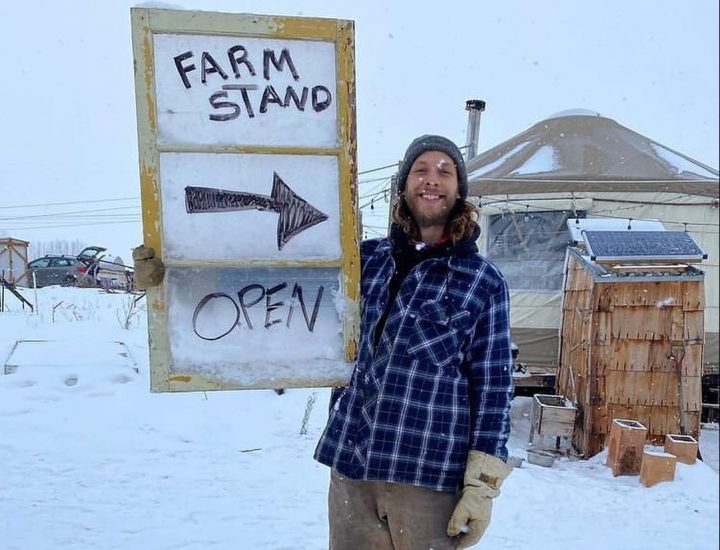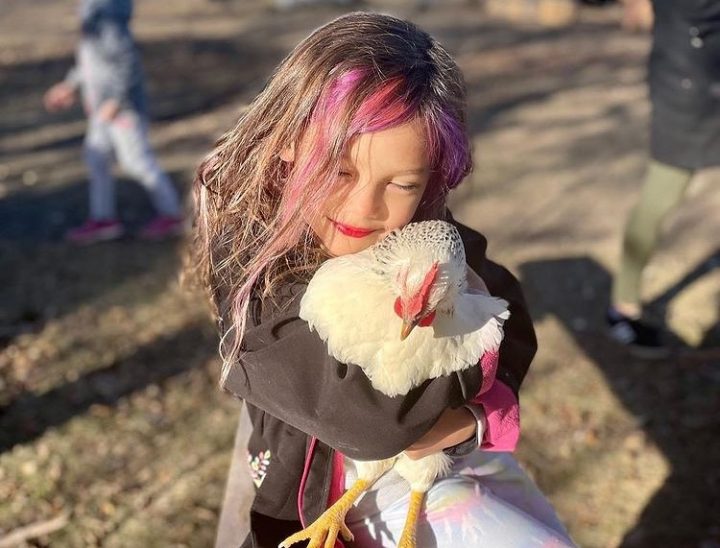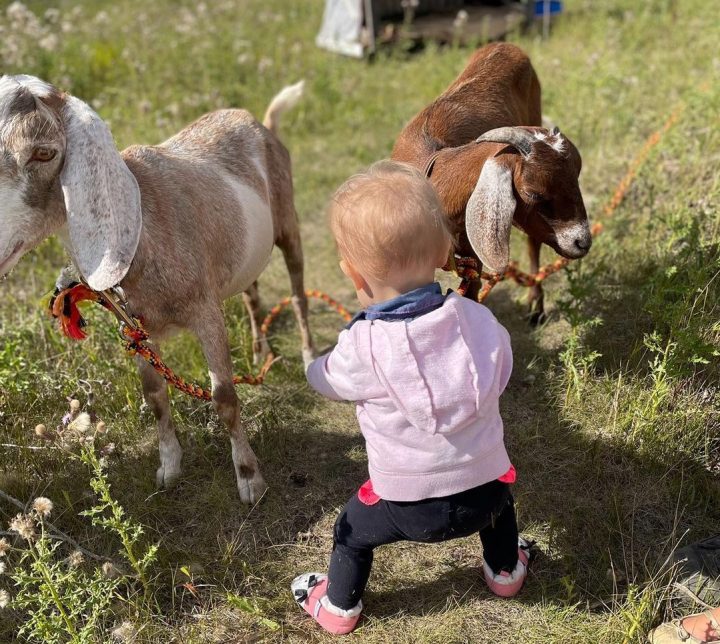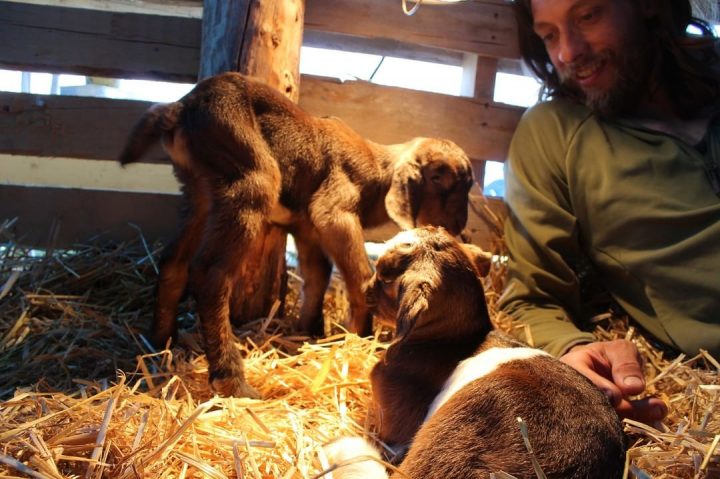FEEDING YOUR COMMUNITY AS A FIRST-GENERATION FARMER
October 5, 2022
Dylan and Tom (and their dogs Coconut and Hank) have jumped into farming with both feet! They are first-generation, queer farmers who started Coconut Grove Urban Farmstead near Edmonton. Tom and Dylan shared with us some of the highlights and lessons learned of their first three years of farming and how they are feeding their community as first-generation farmers.
You can follow their farm journey on IG @coconutgroveurbanfarmstead and on their website coconutgroveurbanfarmstead.com.
JOYS AND STRUGGLES OF BEING NEW FARMERS
Tom and Dylan found land for lease near Edmonton through the Young Agrarians U-Map and decided to make that land their new farm and home – an urban farmstead. When they moved there it was all pasture so they started by setting up a small yurt to live in and tilling a plot for their market garden. Despite the property being very close to urban areas, there was no power or water hookups. So they built an off-grid setup with a wood stove for heat and solar panels for power. Dylan laughs that “sometimes we feel more remote than we actually are – we’re taking solar showers behind the yurt but you can see fast food joints just over the hill.”
As first-generation farmers, these have all been new experiences and it’s been a steep learning curve. As Dylan says, “we had never grown a vegetable before but we decided to start a market garden CSA!” They’ve had mixed success with the veggies and are learning which plants do well in which part of the garden and how to maintain good soil health.
“It’s been so exciting to see how complementary plants like chamomile attract beneficial insects that have protected our greens from flea beetle and cabbage moth. I can’t wait to experiment with more herbs and flowers to support a diversity of insects in the market garden.”
Within the next two years, they also added a flock of chickens and a small herd of milking goats. The pasture-raised meat birds were recently butchered on-farm and sold directly to their customers. It was the first time Dylan had butchered chickens before so it was an intense experience and it took some time to figure out efficient systems for processing and packaging the birds.

The goats are rotationally grazed with new pasture each day. After morning milking, the goats are guided to their grazing area by Dylan energetically sprinting and waving some tempting willow branches that the goats like. Animal health and happiness is a top priority for Dylan and he enjoys this way of using positive energy to move goats (and keep them out of the corn).
The first years of farming have not been without their challenges, though. For example, this spring their irrigation pump got flooded, so now Dylan hauls buckets of water by hand from the nearby creek for the animals and the garden has had to go without irrigation. Tom and Dylan have also learned a lot about living in a yurt and they have had to contend with fierce winds and cold weather. The threat of local grass fires also caused a lot of stress during the summer last year. It’s incredible how much there is to learn when it comes to starting a farmstead!

INVESTING IN LEASED LAND
Farming requires investing in the land, which includes building infrastructure to support your operation and promoting healthy soil. When you are farming on leased land, though, there is a tension between needing to invest to have a successful operation and not committing fully because of uncertain land tenure. This is especially true when you’re starting a farm and have limited resources to invest. Tom and Dylan are feeling this tension and are adapting their farm to be mobile but also rooted in the gifts of the land.
When making decisions about building infrastructure, Dylan and Tom focus on simple structures that are easy to take apart and transport if needed. Their choice of living in a yurt is a reflection of just that! Their goat pens and chicken tractors are also simple structures made from mostly reclaimed and free materials. Having a strong social media presence is also part of making the farm more resilient and allows them to connect with a broad audience.

Despite trying to stay mobile, their farm business is strongly tied to the land, and Tom and Dylan are especially attentive to how they can relate well to the ecosystem around them. They often harvest what is already growing on the land – willow, saskatoons, pig weed, and more – and incorporate it into their CSA baskets, salves, and preserves. They’ve also been planting more trees and shrubs to add habitat and provide wind breaks. Even though Dylan and Tom may never see the direct benefit of these trees, they will support the ecosystem for many years to come.
When farming on leased land it is vital to have a lease that mitigates the risk of being uprooted and that outlines clear expectations for the landholder and lessee. These robust leases can be tricky to put together and if elements are missing or unclear it can lead to conflict. Resources like the Alberta Land Access Guide provide checklists and lease templates. It’s important to build off those to also include compensation clauses and clearly outline responsibilities and expectations.

Tom and Dylan wish they had had support with negotiating and writing a lease because there are so many details that need to be considered – lease rate and payment terms, how to renew or end the lease, conflict resolution, who is responsible for upkeep and maintenance of the permanent infrastructure, and more. Dylan and Tom had to renegotiate their lease many times as different elements became evident. For example, responsibility for road maintenance and improvement wasn’t assigned in the original lease and Dylan noted that “this has proved to be a challenge because the road is prone to flooding.”
“We were completely new to leasing farmland so there were a lot of unknowns. We wish we had had support with figuring out what to include in the farm lease and with negotiating terms and rates that were fair for both sides. It would have been so helpful to have a neutral third party when it came to lease discussions.”
Dylan shared that the more time he spends on the land farming and observing who is there and what they’re doing, the more he falls in love with the place. And the more he falls in love, the more committed he is to making sure that it is a thriving and diverse landscape. This kind of attachment is what many new farmers are looking for and the kind of thing that can’t be written into a lease.
COMMUNITY BUILDING IN A NEW RURAL SPACE
Moving to a rural space where you don’t know anyone can be intimidating and isolating. So Tom and Dylan have been making a point to build connections in their new community from day one. From putting up hand-drawn posters to attract CSA customers, to offering farm tours and workshops, to talking shop with the retired farmers next door, Dylan and Tom have been actively working to bring people to their farm and to share the beauty and joy of growing food.

And their efforts are paying off in a multitude of wonderful ways. So many people are excited about all the activity at Coconut Grove. Folks bring their children and grandchildren to visit the chickens, hang out with the goats, and eat lettuce from the garden. Many of the neighbours have also offered up their personal gardens to help supplement the farm’s CSA. In turn, Dylan and Tom farm-sit for their neighbours and help them out wherever possible. Coconut Grove also hosted a “car boot” sale, much like a pop-up farmers market, on their land as a way to support other local businesses and bring people together on the farm.
Recently, Dylan and Tom found out that the land they are leasing has been slated for re-zoning. The neighbour’s land is also going to be affected, so Tom and Dylan are going to do their best to team up with those who are invested in the land in that area to keep the farm and the ecosystems around it from being developed. Defending the land that Dylan and Tom care for and that has supported them is an integral part of their farmstead.

ADVICE FOR NEW FARMERS
Tom and Dylan have grown and learned a lot on the land over the last three years. Here they share some advice to folks who also want to feed their communities as new farmers.
If you know your heart is out on the land, do everything you can to get out there and find it. As a first generation homesteader, figuring out systems was and is my biggest learning curve. After spending thousands at hardware stores; I recommend getting a sawmill early on, training your eyes to see level, and start collecting old resource books from thrift shops. Part of our mission here is to go back to old ways of agriculture. We like these methods, because they typically inspire community involvement, include hands-on physical effort and naturally creates a respect for the plants and animals that sustain us. What I enjoy most about this lifestyle are the obvious fruits of our labor. Eating great nutritious foods, sharing and providing for our local community and creating a gathering place for people to connect is what fuels us. Much of our culture stems from food production and consumption. Maintaining a local connection to food enriches the local culture and creates greater food security!
Looking back so far at our three-year journey, I’m proud of us for taking a leap into a sovereign, off-grid lifestyle. Being humbled by failure, yet wiser through perseverance, I imagine no other way of making a transition away from urban life.
– Tom

I think I would say that you need to enjoy the work. Make chores enjoyable and something that simply must be done. This life requires us to work from sun up to sun down with very little to no fiscal pay. It is very easy to get caught up in the sheer magnitude of everything that seemingly needs to be done in order for not only the farm to survive but for us to survive as farmers. I heard this piece of advice “just keep putting one foot in front of the other” and I found that when you actually do this, you will see yourself start a 12 week CSA and with all those feet in front of each other you will see yourself finish it. In this same context you will weather storms, survive -57ºC in a yurt, doula goat births, learn to produce food for yourself and community, and navigate the ever changing realm of being first generation farmers attempting to return to the land.
On those days where you do not enjoy the work (you will have them), I lean heavily on my sense of responsibility to the land that I have been entrusted to look after. I value this responsibility because it has fulfilled my life in a way that I have never experienced before.
I do not know what our future has in store on this land because sometimes the process of development feels like a steamroller, all I know is that my purpose for living is rooted in this lifestyle and for that I am thankful.
– Dylan

Are you also wanting to farm and feed your community? Read our blog post on how to start farming in Alberta and check out the Young Agrarians Apprenticeship Program and the Business Bootcamp for New Farmers!


 Filter by Popular Categories
Filter by Popular Categories
